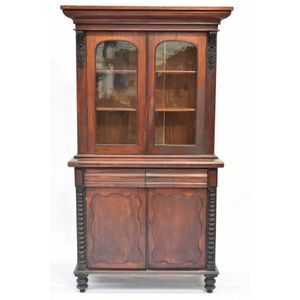Walnut Belle Epoque Buffet with Glazed Doors
You must be a subscriber, and be logged in to view price and dealer details.
Subscribe Now to view actual auction price for this item
When you subscribe, you have the option of setting the currency in which to display prices to $Au, $US, $NZ or Stg.
- Provenance - A term used to describe the provable history of an antique or work of art, and thus an additional aid to verifying its authenticity. Provenance can have an inflating effect on the price of an item, particularly if the provenance relates to the early settlement of Australia, a famous person, or royalty. Less significant are previous sales of the item through an auction house or dealer.
- Belle Epoque - The Belle Époque, also known as the "Beautiful Era," was a period in European history that lasted from the late 19th century to the outbreak of World War I in 1914. The term is most commonly associated with France, but is also used to refer to the same period in other countries, particularly in Western Europe and Latin America.
During the Belle Époque, Europe experienced a time of great prosperity and cultural, artistic, and scientific advancements. It was an era of peace and optimism, characterized by industrial growth, urbanization, and new technologies such as electricity, automobiles, and the telephone. The period is also associated with a flourishing of art and culture, particularly in the fields of literature, music, and the visual arts. - Cornice - The upper section of a high piece of furniture such as a bookcase, wardrobe or cabinet that sits immediately on the main structure. The cornice is usually decorated with a variety of architectural mouldings, worked either with a moulding plane or, from the later 19th century, by machine. The front and side of the cornice are mitred together, strengthened by glue blocks, and the back is generally a simple dovetailed rail to hold the structure together. Cornices are generally, though not always, fitted separately to the piece and are held in place either by screws sunk into the top board or by wooden corner blocks. A pediment may sit above the cornice, but sometimes the terms cornice and pediment are used interchangeably.
This item has been included into following indexes:
Visually similar items

An outstanding Victorian burr-walnut bookcase, with a pair of glazed doors flanked by corbels, the lower section with a pair of panelled doors, also flanked by corbels, 237 cm high, 113 cm wide, 50.5 cm deep. Maker: James Winter & Sons, 1 Wardour Street, S

A fine French walnut breakfront bookcase, with arched pediment carved with shell flanked by S scrolls and turned finials above three glazed doors enclosing shelves, the lower section with three drawers flanked by corbels, above three panelled door, on a st

An Australian cedar bookcase, c. 1880, in good original untouched condition, 217 x 126 x 45 cm

A European pine bookcase chiffonier, the upper section with two glazed doors, the lower section with two drawers above two cupboards. 116 cm x 48 cm x 245 cm
